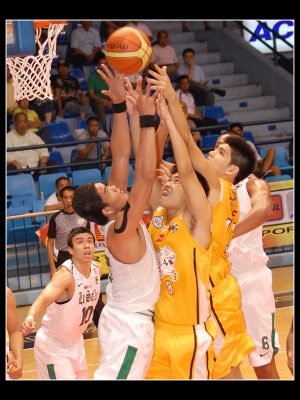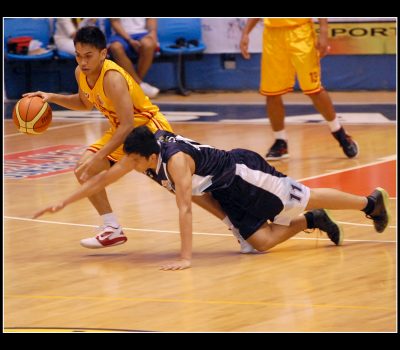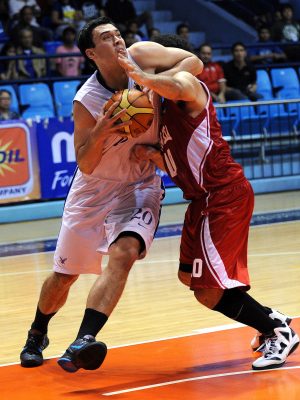A big boost for collegiate basketball
BIZLINKS by: Rey Gamboa
Let me dwell again with one of my loves in life – basketball, particularly collegiate basketball.
Taking off from the success of the Collegiate Champions League, which was relaunched in 2001, is a wider, more grassroots-based search for the foremost collegiate basketball squad in the land. Again, it goes without saying that the theme continues: There can only be one!
Recently, the Philippine Collegiate Champions’ League (PCCL) – which has been organizing inter-collegiate basketball tournaments among teams from Luzon, Visayas and Mindanao – joined hands with the Samahang Basketbol ng Pilipinas (SBP) in a bid to further strengthen the collegiate basketball landscape thru a nationwide school-based competition.
The SBP and PCCL are piecing together a more extensive and comprehensive multi-level basketball league. To be called the Philippine Collegiate Championship Games, the ultimate aim is to further widen the base of competition nationwide to determine which team ultimately should deserve the title of Philippine Collegiate basketball champion.
The template for this nationwide search for the best collegiate team adopted by PCCL has put in place local, regional and zonal level competitions in key cities and provinces to ensure that more collegiate squads are given the opportunity to show their mettle not just within the confines of their respective “mother leagues” but also across provincial and regional borders.
The road to the national championship
For this nationwide competition, the country is divided into nine regional areas. In the first level, teams from existing collegiate leagues within each regional area will do battle, with the top four survivors advancing to the second level or the regional area championship.
The four qualifiers from the first level will clash to determine the regional area champion that will represent the area in the zonal championship, which is the third level in the road towards the national championship.
In the zonals, the regional area champions will be joined by other teams from major leagues in Metro-Manila such as the third and fourth placers of the UAAP, NCAA, South NCAA Champion and runner-up and also by “wild card entries,” or teams that rank well considering their performance in their respective “mother leagues” and in invitational tournaments such as the Fr. Martin, FilOil Flying V Pre-Season, etc.
Two teams from each zone will advance to be the top eight survivors of the zonal competitions, and will then join the eight seeded teams, namely the champions and runner-ups of the NCAA and UAAP, and the champions of major leagues such as CESAFI (Cebu), CUSA, NAASCU and NCRAA/UCAA, to slug it out in the now familiar Sweet Sixteen format.
Truly a nationwide league
In developing a league with a broadened scope to crown a truly national collegiate champion, more teams are given an avenue to look beyond their borders.
This way therefore, whoever grabs the national title for the season can truly claim to have survived the tough road to the championship competing with the best teams that other provinces and regions have to offer.




Cross fertilization of skills
The format of the Philippine Collegiate Championship allows competitive but relatively unknown teams that are not in the media limelight to pit skills with the glamorous and media-hyped teams from Metro Manila. For sure, Manila-based cagers could learn a thing or two from their provincial rivals and vice-versa. Call it a basketball transfer of technology or skills.
The PCC games are fitting gauge of a team’s strength and skills, or its ability to measure up to the challenge of other rivals beyond their usual borders. Collegiate team players are encouraged to aim higher to not only be their league’s champion, but even a national collegiate champion – a Champion of Champions.
Good players can only get better when ranged against tougher opponents, which is what the league is after. Faced with must-win situations in each game, the league also reinforces the need for players and their teams to be ready and all-out for each battle, giving no space for slacking off. This is a guarantee for hard-fought matches each time.
The PCC games also encourage schools to put in place a solid sports development program given the opportunities for a broader competitive environment and more extensive public and media exposure.
Beyond archipelagic borders
Prizes at stake for the top four teams in the Finals include P500,000 grant for scholarship and athletic facilities for the Philippine champion. The runner-up along with the third and fourth placers would receive a generous package of P200,000, P100,000 and P50,000, respectively, of scholarships and equipment grants as well.
Other than the material rewards and adulation of the local basketball community, the eventual Philippine Collegiate champion will be fully recognized by FIBA, and will therefore get an opportunity to carry the national tri-color at FIBA-sanctioned international competitions such as the Universiade Games in Serbia in 2009.
Organized by the International University Sports Federation, Universiade is a multi-sport event participated in by university students worldwide. It is also more commonly known as the World Student or World University Games.
Rivalries revisited
As a possible offshoot of the forthcoming Philippine Collegiate Championship, basketball fans may look forward to the resumption of furious collegiate basketball rivalries that in the past awoke furious passions and undying loyalties.
Old-timers will agree that even before the now-fabled Ateneo-La Salle rivalry, there was the intensely notorious Ateneo-San Beda duel which resulted in many dramatic and thrilling episodes on and off the court.
And what about the bigger rivalry between Cebu and the so called Imperial Manila? While many southern stars are recruited and find their way to Metro Manila-based schools, it’s a different thing altogether when a pure Visayan collegiate squad squares off with Manila-based opponents.
These are rivalries that not only improve the skills of players but likewise bring unforgettable thrills to the Filipino basketball fan, who truly has made what Philippine basketball is today.

